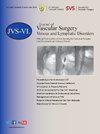Effectiveness and safety of sirolimus in the treatment of venous malformations: A meta-analysis of prospective studies
IF 2.8
2区 医学
Q2 PERIPHERAL VASCULAR DISEASE
Journal of vascular surgery. Venous and lymphatic disorders
Pub Date : 2025-07-05
DOI:10.1016/j.jvsv.2025.102284
引用次数: 0
Abstract
Background
Venous malformations are prevalent vascular anomalies. Recent clinical studies have explored the use of sirolimus for these conditions, particularly in patients who are not candidates for, or have shown limited response to, traditional treatments such as sclerotherapy and surgery. This meta-analysis systematically evaluates the efficacy and safety of sirolimus in treating venous malformations.
Methods
We conducted searches in PubMed, Cochrane Library, Web of Science, and the Cochrane Database of Systematic Reviews until August 10, 2024. The quality of the included prospective studies (including both randomized and single-arm pre-post trials) was assessed using the Cochrane risk of bias tool. Statistical analyses were performed with Review Manager (Version 5.4).
Results
Our analysis included eight prospective studies involving 74 patients. Primary outcomes measured changes in the volume and size of the malformations. Secondary outcomes assessed were functional disability scores, hemoglobin levels, coagulation indices, transfusion requirements, patient quality of life, and radiologic responses. Sirolimus demonstrated significant therapeutic benefits, with an odds ratio of 0.02 (95% confidence interval, 0.00-0.08) across six studies evaluating dichotomous variables. Results for continuous variables were consistent. Sirolimus showed safety in short-to medium-term use, with reversible mild to moderate side effects such as oral ulcers and liver function abnormalities. No severe adverse events (grade 3-5) were reported.
Conclusions
Sirolimus is effective and safe for treating venous malformations, especially in patients unresponsive to conventional therapies. Future studies should explore long-term effects, optimal dosages, and administration techniques.
西罗莫司治疗静脉畸形的有效性和安全性:前瞻性研究的荟萃分析。
背景:静脉畸形是一种常见的血管异常。最近的临床研究探索了西罗莫司在这些疾病中的应用,特别是在不适合或对硬化疗法和手术等传统治疗反应有限的患者中。目的:本荟萃分析系统评价西罗莫司治疗静脉畸形的疗效和安全性。方法:截止到2024年8月10日,我们在PubMed、Cochrane Library、Web of Science和Cochrane Database of Systematic Reviews中进行了检索。使用Cochrane偏倚风险工具评估纳入的前瞻性研究(包括随机和单臂前后试验)的质量。使用Review Manager (Version 5.4)进行统计分析。结果:我们的分析纳入了8项前瞻性研究,涉及74例患者。主要结果测量畸形的体积和大小的变化。评估的次要结果是功能障碍评分、血红蛋白水平、凝血指数、输血要求、患者生活质量和放射反应。西罗莫司显示出显著的治疗效果,在6项评估二分类变量的研究中,比值比为0.02[0.00,0.08]。连续变量的结果一致。西罗莫司在中短期使用中表现出安全性,具有可逆性轻至中度副作用,如口腔溃疡和肝功能异常。无严重不良事件(3-5级)报告。结论:西罗莫司治疗静脉畸形安全有效,尤其适用于对常规治疗无反应的患者。未来的研究应该探索长期效果、最佳剂量和给药技术。
本文章由计算机程序翻译,如有差异,请以英文原文为准。
求助全文
约1分钟内获得全文
求助全文
来源期刊

Journal of vascular surgery. Venous and lymphatic disorders
SURGERYPERIPHERAL VASCULAR DISEASE&n-PERIPHERAL VASCULAR DISEASE
CiteScore
6.30
自引率
18.80%
发文量
328
审稿时长
71 days
期刊介绍:
Journal of Vascular Surgery: Venous and Lymphatic Disorders is one of a series of specialist journals launched by the Journal of Vascular Surgery. It aims to be the premier international Journal of medical, endovascular and surgical management of venous and lymphatic disorders. It publishes high quality clinical, research, case reports, techniques, and practice manuscripts related to all aspects of venous and lymphatic disorders, including malformations and wound care, with an emphasis on the practicing clinician. The journal seeks to provide novel and timely information to vascular surgeons, interventionalists, phlebologists, wound care specialists, and allied health professionals who treat patients presenting with vascular and lymphatic disorders. As the official publication of The Society for Vascular Surgery and the American Venous Forum, the Journal will publish, after peer review, selected papers presented at the annual meeting of these organizations and affiliated vascular societies, as well as original articles from members and non-members.
 求助内容:
求助内容: 应助结果提醒方式:
应助结果提醒方式:


